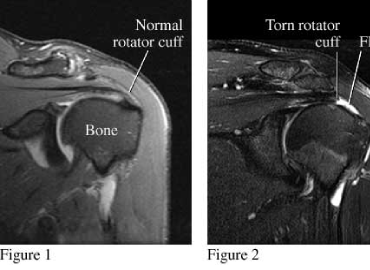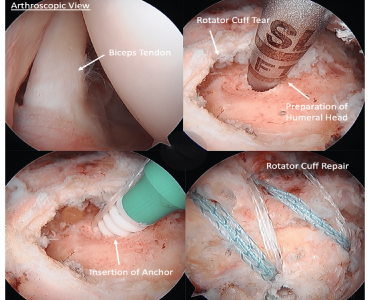Rotator Cuff Surgery
Home / Rotator Cuff Surgery
Rotator Cuff Surgery
Get AppointmentWhat is Rotator Cuff?
A Rotator cuff is a group of muscles and tendons that surround the shoulder joint, keeping the head of the upper arm bone firmly within the shoulder’s shallow socket.
Rotator cuff tears are a common source of shoulder pain. The incidence of rotator cuff damage increases with age and is most frequently caused by degeneration of the tendon rather than injury from sports or trauma.
Cause
The rotator cuff can be torn from a single traumatic injury. Patients often report recurrent shoulder pain for several months and a specific injury that triggered the onset of the pain. A cuff tear may also happen at the same time as another injury to the shoulder, such as a fracture or dislocation.
Most tears, however, are the result of overuse of these muscles and tendons over years. People who are especially at risk for overuse are those who engage in repetitive overhead motions. These include participants in sports such as baseball, tennis, weight lifting, and rowing.
Rotator cuff tears are most common in people who are over the age of 40. The blood supply to the rotator cuff diminishes with age and transiently with certain motions and activities. The substance of the tendon itself degenerates over time. Because of the decrease in tendon blood supply, the body’s ability to repair tendon damage is decreased with age; this can ultimately lead to a full-thickness tear of the rotator cuff.
Rotator cuff tears may often happen as a result of wear and tear. An extrinsic factor that can cause damage to the rotator cuff is the presence of bone spurs underneath the acromion (the bony tip of the outer edge of your shoulder blade (scapula) that comes off the top of the back side of this bone. It meets with the end of your collar bone (clavicle) at your shoulder) The spurs rub on the tendon when the arm is elevated; this is often referred to impingement syndrome. Combining this with a diminished blood supply, the tendons have a limited ability to heal themselves. These factors are at least partly responsible for the age-related increase in rotator cuff disease and the higher frequency in the dominant arm.
Younger people tend to have rotator cuff tears following acute trauma or repetitive overhead work or sports activity.
Types of Rotator Cuff Tears
- Acute Tear-If you fall down on your outstretched arm or lift something too heavy with a jerking motion, you can tear your rotator cuff.
- Degenerative Tear– Most tears are the result of a wearing down of the tendon that occurs slowly over time. This degeneration naturally occurs as we age.
- Partial tear-This type of tear is also called an incomplete tear. It damages the tendon, and the tendon no longer fully attaches to the head of the humerus.
- Full-thickness tear-This type of tear is also called a complete tear, with a full-thickness tear, there is basically a hole in the tendon.
Symptoms of Rotator Cuff Tears
Some of the signs of a rotator cuff tear include:
- Atrophy or thinning of the muscles about the shoulder
- Pain when lifting the arm
- Pain when lowering the arm from a fully raised position
- Weakness when lifting or rotating the arm
- Crepitus or crackling sensation when moving the shoulder in certain positions
Symptoms of a rotator cuff tear may develop right away after a trauma, such as a lifting injury or a fall on the affected arm. When the tear occurs with an injury, there may be sudden acute pain, a snapping sensation, and an immediate weakness of the arm. Symptoms may also develop gradually with repetitive overhead activity or following long-term wear. Pain in the front of the shoulder radiates down the side of the arm. At first, the pain may be mild and only present with overhead activities, such as reaching or lifting. It may be relieved by over-the-counter medication.
Over time the pain may become noticeable at rest or with no activity at all. There may be a pain when lying on the affected side and at night.
Diagnosis

Diagnosis of a rotator cuff tear is based on the symptoms and physical examination. X-rays, and imaging studies, such as MRI or ultrasound, are also helpful.
Physical examination includes looking for any tenderness or deformity including the Impingement sign. The range of motion of the shoulder is measured in several different directions and the strength of the arm is tested. We also check for instability or other problems with the shoulder joint.
We will also examine the neck to make sure that the pain is not coming from a ” pinched nerve ” in the cervical spine and to rule out other conditions, such as osteoarthritis or rheumatoid arthritis.
Plain X-rays of a shoulder with a rotator cuff tear are usually normal or show a small spur. For this reason, an MRI may be required to better visualize soft tissue structures such as the rotator cuff tendon. The MRI can tell how large the tear is, as well as its location within the tendon itself or where the tendon attaches to the bone.
Treatments
Non-Surgical Treatments
This method of non-surgery is advised for very small tears or irreparable tears where strengthening the muscle around the shoulder girdle has proven to provide comfort and improvement in the shoulder’s functionality in some of the patients but non-surgical treatments have the following disadvantages:
- Chances of the tear increasing over time
- Limited activities due to the restriction of the shoulder’s movement.
Some of the non-surgical treatment options include:
RestThe doctor would recommend resting and limited overhead activities and usually, the doctor might prescribe a sling to protect the shoulder and keep it stationary.
Modify ActivityThe doctor might suggest avoiding certain actions and activities to prevent shoulder pain.
Non-Steroid Anti-Inflammatory MedicationMedications like Acetaminophen, Ibuprofen, and Naproxen are prescribed by the doctor to relieve pain and reduce swelling.
Physical TherapyThe doctor might also suggest physical therapy and certain exercises for strengthening shoulder muscles, restoring movement, improve flexibility and range of motion. These exercises will help the shoulder to relieve pain and also prevent further shoulder injury.
Steroid TreatmentThe doctors might include steroid injections as part of the treatment plan if resting, medications and exercises do not relieve the pain. This injection is a combination of a local anaesthetic and cortisone, an anti-inflammatory medicine.
Stem Cell TreatmentThis is an alternative treatment method for rotator cuff tears. In this approach, the stem cells are extracted from an area of higher density and then harvested, and then re-injected into the damaged area to help the natural healing process.
Surgical Treatments
The type of repair performed depends on several factors considering the type of tear, age, activity level, and general health. The surgeon will discuss with you the best procedure to meet your individual health needs.
Techniques most commonly used for rotator cuff repair include
- Open repair
- Arthroscopic repair
- Mini-open repair

Open repair – An open surgical incision is performed if the tear is large or complex. The surgeon makes the incision over the shoulder and detaches one of the shoulder muscles (deltoid) to gain access to the torn tendon.
Arthroscopic Repair-This is a less invasive procedure. During arthroscopy, the surgeon inserts a small camera, called an arthroscope, into the shoulder joint to guide through the surgery, and other miniature surgical instruments are inserted to repair the torn rotator cuff.
Following the repair, fluid is allowed to drain from the shoulder, and a sterile bandage is applied in order to keep the shoulder muscle immobile while it heals a sling is provided.
Mini-Open Repair – It is performed through a small incision. The incision is typically 3 to 5 cm long. While performing the tendon repair, the surgeon views the shoulder structures directly, rather than through the monitor.
Recovery After Surgery
Complete recovery may take several months.
Pain Management– After surgery, you will feel pain which will be controlled by the use of NSAIDs.
Rehabilitation– Rehabilitation is important in getting you back to your daily activities. Physiotherapy will help you regain shoulder strength and motion.
Immobilization –Initially the repair needs to be immobilized while the tendon heals, to avoid using your arm for the first 4 to 6 weeks you will be given a sling
Passive exercise– Usually, passive exercises are started within the first 4 to 6 weeks after surgery.
Active exercise– After 4 to 6 weeks, you will be doing active exercises.
GET APPOINTMENT
Schedule Appointment : Your Path to Specialized Care
Get rid of your pain, stress, and enduring with our 24/7 dental services. It's a priority to relieve the pain in surgeon as much as possible. 90% of customers claim that they would come back & recommend us to others.
